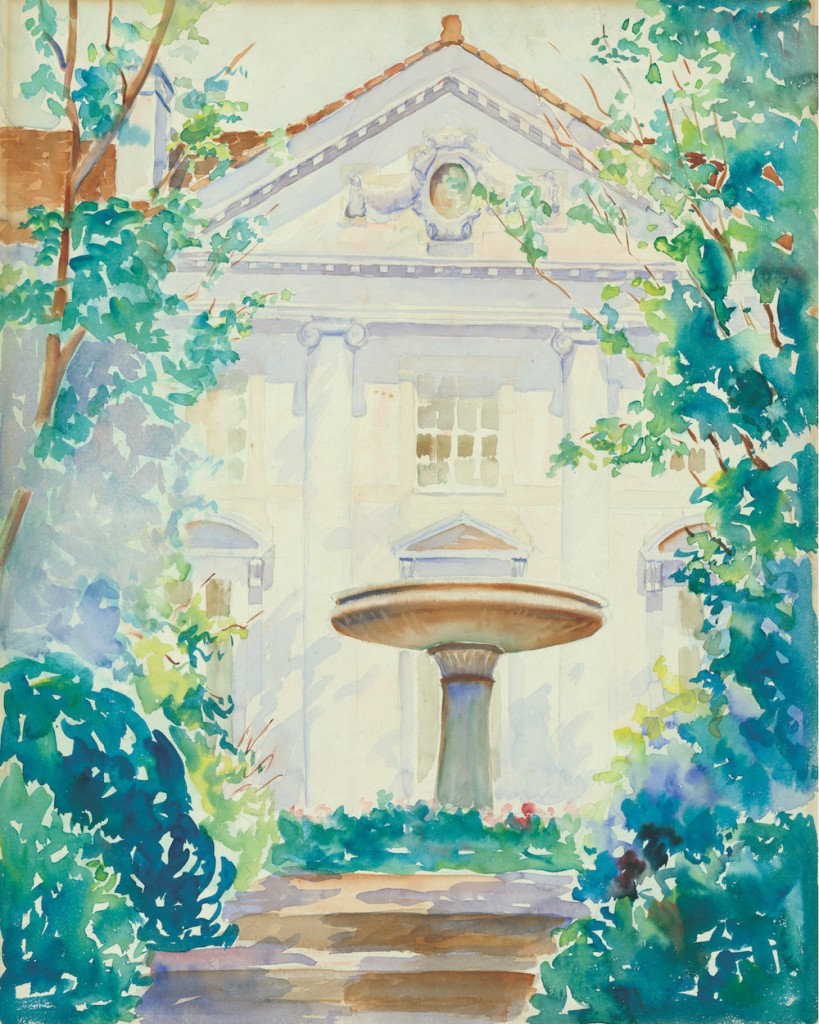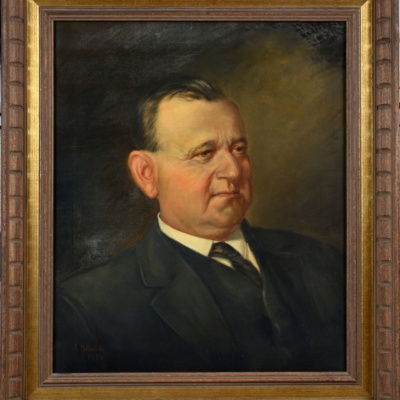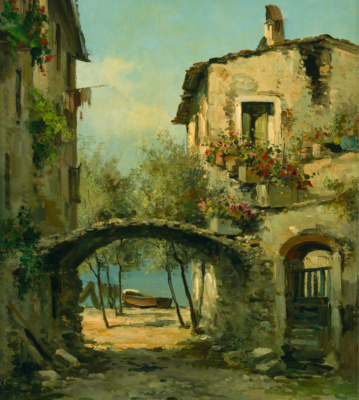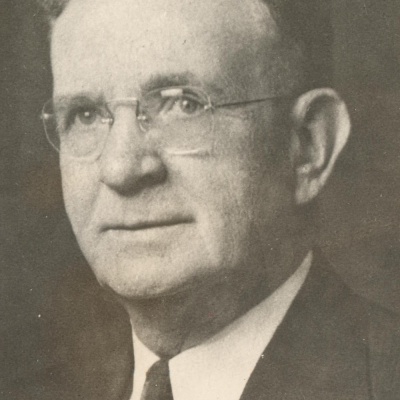This year is the 100th anniversary of the birth of Lamar Dodd and we take this opportunity to reflect on his life, art and career. Hills & Dales Estate is honored to have two Lamar Dodd works as a result of his lifelong friendship with Fuller Callaway Jr. A watercolor depicting the south elevation and fountain was given to Fuller and Alice as a wedding gift and a charcoal sketch of sailboats was given as a thank you gift for a weekend stay at Hills & Dales Estate.
Lamar Dodd was born in Fairburn, Georgia on September 22, 1909. He descended from a line of Baptist ministers and successful businessmen. Dodd’s mother, Etta Irene Cleaveland, was from a well-established family in Troup County and moved to LaGrange when her brother bought a beautiful Greek Revival home, “The Oaks” on Vernon Street diagonally across the street from Hills & Dales Estate.
Lamar Dodd’s artistic talent was noted early. In the sixth grade he was allowed to take art lessons at the Southern Female College in LaGrange. Inspired by his surroundings, he began to paint original works, some of which are still in the possession of local families. Even though he intensely valued life in a small town and later remarked it was a “good place for an artist-to-be to begin,” he bowed to the pressure of finding a proper profession and briefly studied architecture at the Georgia Institute of Technology, followed by a brief teaching stint in Alabama. In 1928, he enrolled in the Art Students League of New York to further his art training. One of his finest works, Ninth Avenue El, was completed during this time. Dodd’s affinity for the “American Scene” and especially his use of Southern images continued to be his trademark style.
In William Eiland‘s book, The Truth in Things, he describes Dodd’s painting style as “capturing the essence of ordinary objects, the beauty of the natural landscape, the wondrous excitement of a rocket’s blast–off, the incredible moment of open heart surgery, all with an eye so skilled that the moment rendered in paint becomes transmuted into the event, the object itself.”
After marrying Mary Ridley Lehmann in 1930, the Dodds lived in LaGrange a year before moving back to New York for three more years of study with the Art Students League. In 1933, he and Mary moved to Birmingham, Alabama, where he worked in an art store and painted inspirational pieces of the South. In 1936 he sent The Railroad Cut, a painting of a slag dump outside Wylam, Alabama, to the Art Institute of Chicago where it won one of the Institute’s most prestigious awards. Dodd was appointed to the faculty of the University of Georgia in 1937. Within three years he organized a visual arts department and enrolled the first graduate students into a master’s program.
Later on, Callaway contacted Dodd to give him oil painting lessons. Correspondence between the two during 1952 and 1953 reveals Fuller’s appreciation for Dodd taking the time to work with him and Dodd’s enjoyment of the experience. Dodd chose brushes, paints, pastels, and palette knives for Callaway at an art store in Athens,Georgia, and had them sent to Callaway. Callaway secured for Dodd a Minox camera, film, and a tripod to use on his upcoming trip to Europe and gave instructions on the application of film speeds. In 1953, he received a joyous letter from Callaway stating: “Success at last. I finally have a Callaway hanging in the first floor library of Alice’s home! I am sorry to say that it has replaced your Sailboats.” Dodd’s reply: “Congratulations! Either your painting has improved or Alice’s taste has improved!”
In the 1960s, Dodd was invited to be an official National Aeronautical Space Administration (NASA) artist. He was overwhelmed by the experience and produced twenty-five new paintings from his eyewitness account of numerous NASA events. Many were created with gold and silver leaf adding to the exaltation of this significant moment in the history of mankind.
The late 1970s took Dodd from the mysteries of space travel to the mysteries of open-heart surgery. His beloved wife, Mary, was hospitalized in 1977 for a serious heart condition. Dodd became immersed in the event and studied slides of open heart surgery and every aspect of her treatment. Her cardiologist, Dr. Craver, arranged for Dodd to come into the operating room to sketch his impressions. Before it was over, Dodd was allowed to witness twenty-five operations. The group of paintings and drawings from this time reflect “a mystery, the miracle of death and rebirth.”
The paths of the two long-time friends crossed again when Fuller Callaway Jr. had open-heart surgery. In 1983, when the Georgia Heart Clinic in LaGrange was being constructed. John Lawrence, professor of art at LaGrange College, suggested to Dr. Bob Copeland, a local cardiologist and director of the project, that he approach Lamar Dodd and commission a special entryway painting. Dr. Copeland was also Fuller’s cardiologist. After meeting with Dr. Copeland, Dodd agreed to execute the work. Dodd emphasized that he wanted his work to honor the history of science and medicine. The Heart of Man, was installed in April, 1984. It is a depiction of Fuller Callaway’s open heart surgery. Following this project, a new conversation developed regarding Dodd’s earlier heart series. Dodd’s ultimate goal for this important body of work was that it be kept together and presented in a meaningful display. It seemed that he had found a home for the collection in LaGrange. With a grant from Fuller E. Callaway Foundation, the Georgia Heart Clinic acquired almost the entire “Heart” series.
In 1989, three years after his first wife died Dodd married Annie Laurie Welch. Annie became a devoted helpmate and companion in the love and creation of works of art. In 1995, the art department Dodd founded at the University of Georgia became known as the Lamar Dodd School of Art. Dodd, even after suffering a serious stroke, continued to paint. Returning to his roots in the natural world, his last works depicted Maine seascapes, sunflower fields, and other beautiful compositions.
Lamar Dodd and Fuller Callaway, Jr. were lifelong friends and both left a wonderful legacy in their chosen careers. We celebrate the 100th anniversary of Lamar Dodd’s birth and reflect on a life full of artistic accomplishment.



